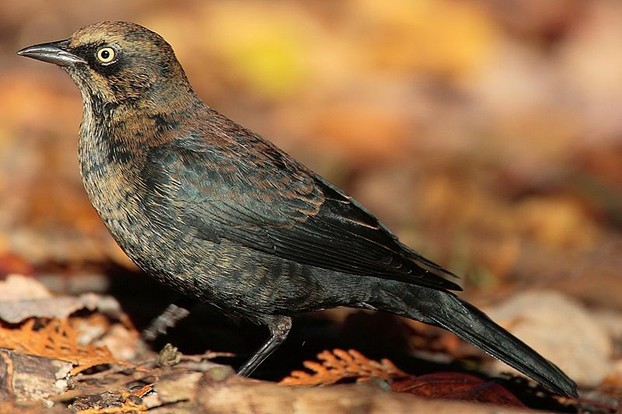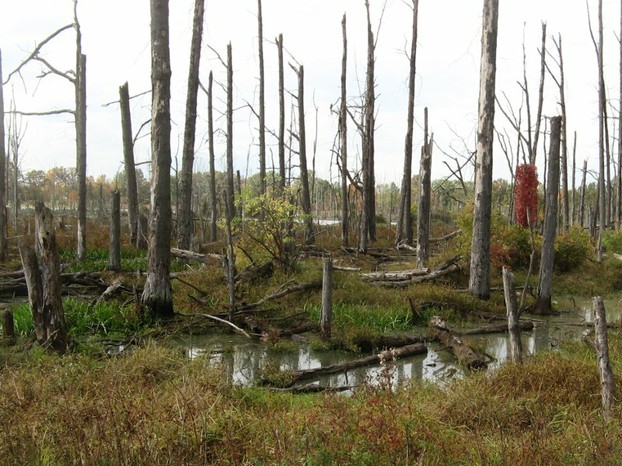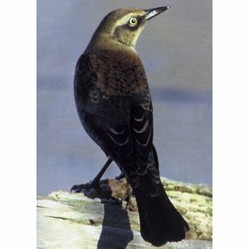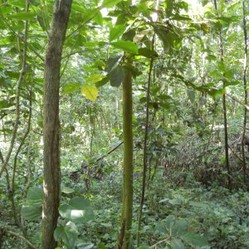As a new world blackbird, the Rusty blackbird is a close relative of the Common Grackle, Red-winged Blackbird, and Brown-headed cowbirds, and has a structure similar to these birds. Identifying it is usually done in comparison to its other close relatives.
The Rusty blackbird is more distinctive in some plumages than others. The male in breeding plumage is black overall, with a pale yellow eye, and is best identified from other all-dark, yellow-eyed blackbirds (such as the common grackle) by size and shape. In winter, the male has significant "rusty" color on it. The female, in non-breeding plumage, is brownest of all, especially on the back and crown.
Most blackbirds are easy to tell apart from the rusty blackbird. The trickiest to tell apart are the Brewer's blackbird: Brewer's blackbirds have a very similar build and structure, and female and juvenile birds of this species have a similar brown coloration. The two different in habitat: Brewer's blackbird frequents grass, whereas the Rusty blackbird favors swamps, especially those in or near forests.
Cornell Lab of Ornithology has excellent ID tips for the rusty blackbird on their site All About Birds.










 The Shaming of Femininity and Elevation of Masculinityon 07/13/2017
The Shaming of Femininity and Elevation of Masculinityon 07/13/2017
 What is Genderqueer or Non-Binary Gender?on 10/16/2015
What is Genderqueer or Non-Binary Gender?on 10/16/2015
 Resources for Learning Spanish Free Onlineon 04/13/2016
Resources for Learning Spanish Free Onlineon 04/13/2016
 Ways Native Plants Can Help Control Invasive Plantson 05/26/2016
Ways Native Plants Can Help Control Invasive Plantson 05/26/2016



Questions? Comments? Feedback?
Yeah...when I travelled through the American West, I became aware of how few wetlands there are out there! I checked eBird, and Rusty blackbirds do visit Colorado in winter, but only in the far eastern part of the state, and they're uncommon there.
Much more common in Colorado is the closely-related western species, Brewer's Blackbird. The two are hard to tell apart without knowledge and a close view. Brewer's blackbirds are found through the whole state, and I think are more common in the west. This bird is not endangered--and it seems to do better around humans than the Rusty Blackbird, so if you see something that looks like this in Colorado, chances are you're probably looking at a Brewer's blackbird.
Very interesting, I'm just a beginning to bird. I live in Colorado where there are not a lot of swamps but we do have some protected wetlands. I'll keep my eyes peeled.
Thank you! I lived briefly in SoCal and became familiar with the Brewer's blackbird, which is the closest relative of the Rusty Blackbird that is native there. Populations of the Brewer's blackbirds though are much more stable, probably because they're adapted to open areas, and thus are more comfortable living around humans.
It is out of my range in SoCal but I am interested in all bird info and This article was very informative.
cazort, Me, too, I'm concerned about rusty blackbirds. I've written about them on other sites, and a while ago I wrote an article which is in my Wizzley to-be-published queue, awaiting its turn in the lineup.
So I'm happy to see rusty blackbirds in the spotlight via your article, with good suggestions for involvement from concerned citizens.
Thank you! I know what you mean about articles that cover problems without talking much about solutions. I want to keep my articles empowering, and give people concrete things they can do to make a positive difference!
I consider myself a beginning level Birder. I mainly got interested because I like to take photos of them, but have to admit I get a little deeper each year. I knew very little of this species before today.
Thanks for the "How can you help" section. Too often you read articles covering various problems, with not enough offers of real solutions. If each person tried to do a little, together we could all do a lot.
I'll have to keep my eye out for Rusty Blackbirds during their migration.
Now I will keep an eye out for this bird.
Great article with lots of useful info. I'm sure this bird would thank you!
Have to admit I'd never heard of the Rusty Blackbird. Now I'll have to look out for it (as it migrates south I guess!)
Yup! Plumage is the right word; you're already talking like an Ornithologist! =) And thank you, KathleenDuffy, I definitely hope this bird recovers too! I think it will if people keep raising awareness of it and studying it the way it has been happening lately.
And Ragtimelil, I definitely see far more grackles than Rusty blackbirds...I probably see a few hundred grackles for every 1 rusty blackbird I've spotted. Grackles are much more likely to show up in a parking lot or around a cafe. On the west coast, this bird's closer relative, the Brewer's blackbird, is likely to frequent outdoor cafes and parking lots too. For some reason, the Rusty blackbird doesn't seem to go around human habitation as much.